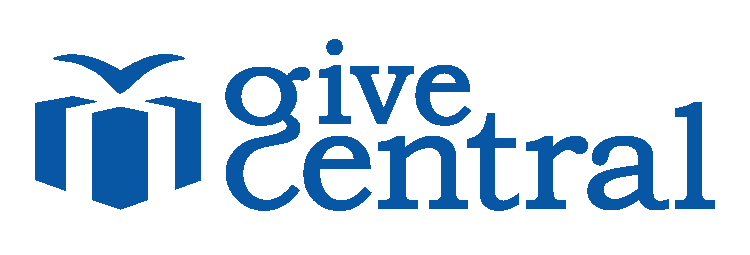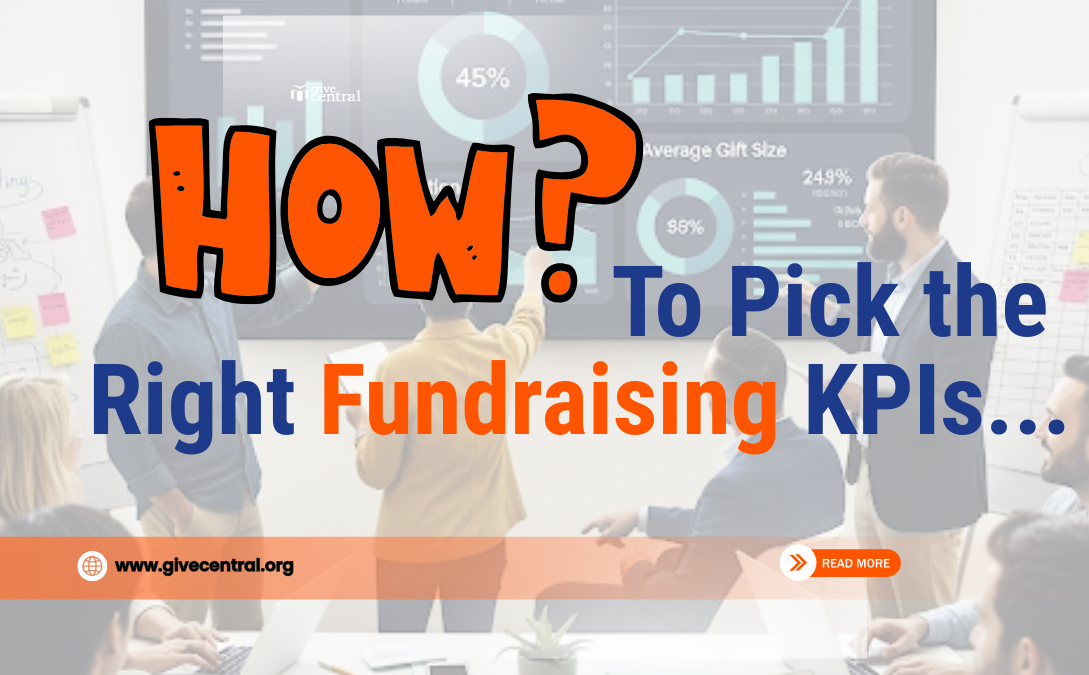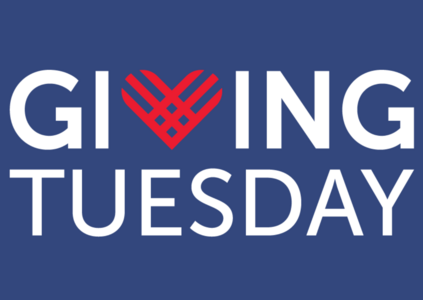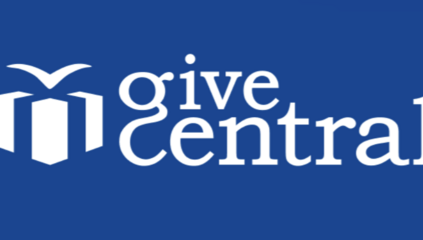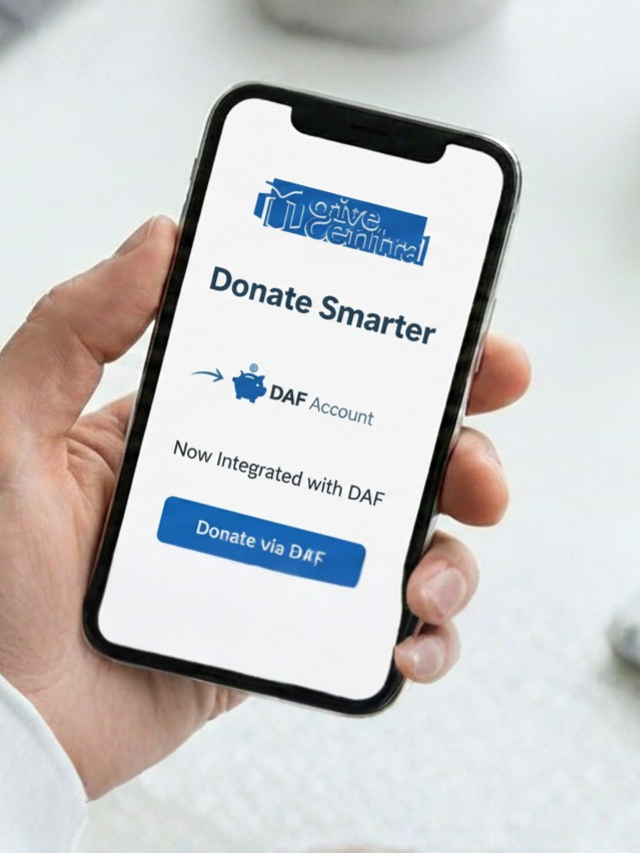Fundraising KPI can feel overwhelming, especially when you’re tracking too many.
Email opens. Clicks. Attendance numbers. It adds up fast. But when it’s time to report to your board or plan your next campaign, those metrics often fall short. The truth is, more data doesn’t mean more donations. You don’t need more metrics. You need the right ones.
At GiveCentral, we believe effective fundraising starts with a handful of clear, actionable KPIs that align with your goals and do not clutter your reports. In this guide, we’ll help you choose, track, and utilize the most important fundraising KPIs, without getting overwhelmed by data.
What Are Fundraising KPIs?
KPI stands for Key Performance Indicator. It’s a number that indicates whether your fundraising is on track. Not how many emails you sent—but how many people gave because of them.
Good KPIs help you measure real progress. They are:
- Tied to clear fundraising goals
- Easy to track regularly
- Designed to inform decisions
Bad KPIs are just noise. They look good on a report, but don’t help your team take action.
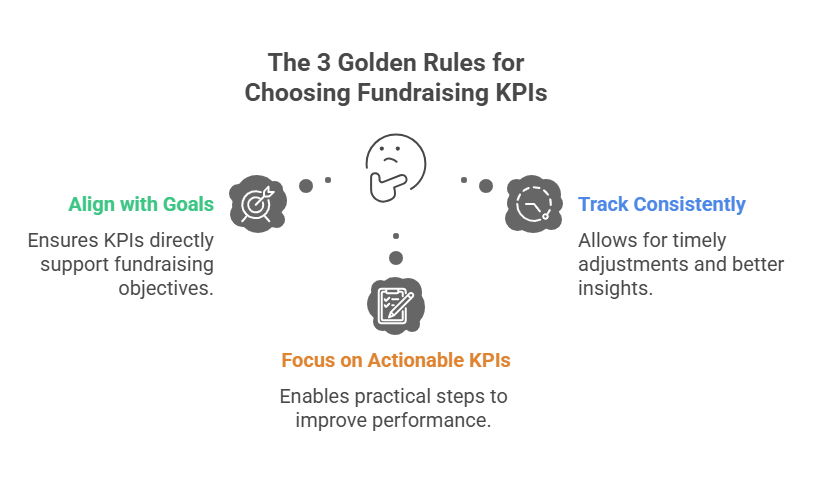
The 3 Golden Rules for Choosing Fundraising KPIs
1. Align Every KPI With a Goal
Ask this question: What is this number helping us achieve?
- If your goal is to increase donor loyalty, track the donor retention rate
- If your goal is to grow major gifts, track pipeline progress
- Every KPI should serve a purpose.
2. Track Fewer Metrics, More Consistently
More KPIs create confusion. Stick to 5–7 that matter most.
At GiveCentral, we help clients build simple dashboards that prioritize clarity. Because the simpler your data, the faster your team can act on it.
3. Focus on Actionable KPIs
If you can’t do something about a number in the next 30 days, it doesn’t belong on your list.
One of our clients trimmed 15 tracked metrics down to 6—and saw a 25% increase in major gift revenue in one quarter. Why? Less distraction, more focus.
7 Fundraising KPIs That Matter
Here are the most impactful KPIs we recommend for nonprofits:
- Donor Retention Rate
What percentage of donors gave again this year?
Retention is cheaper than acquisition—and a key driver of revenue growth. - Cost Per Dollar Raised (CPDR)
How much are you spending to raise every $1?
This helps you measure campaign efficiency and ROI. - Email or Event Conversion Rate
How many people donated after receiving an email or attending an event?
This helps you understand what messaging and formats work.Read more: How Email Marketing Can Improve Nonprofit Fundraising
- Average Gift Size
What’s the average amount your donors are giving?
This metric can reveal trends in donor generosity and giving capacity. - Major Donor Pipeline Progress
Are high-value prospects moving toward giving?
Tracking progress helps you focus outreach and personalize engagement. - Time to First Gift
How quickly are new contacts converting to donors?
The shorter this is, the more effective your acquisition strategies are. - Recurring Donor Growth
How many donors are giving on a monthly or quarterly basis?
“Need clarity on fundraising terms like ‘recurring donor’ or ‘major donor pipeline’? See our 20 Nonprofit Glossary Terms Every Fundraiser Should Know.”
 Recurring gifts provide predictable income and donor loyalty.
Recurring gifts provide predictable income and donor loyalty.
How to Track Fundraising KPIs Without Feeling Overwhelmed
You don’t need fancy tools to get started. Here’s how we recommend tracking:
- Use tools like Google Sheets or GiveCentral’s built-in dashboard
- Review your KPIs once a month, not daily
- Color-code trends for visibility (green for healthy, red for needs attention)
- Visualize your KPIs over time using simple graphs or charts
At GiveCentral, our platform makes this process simple, fast, and customizable—whether you’re a small local nonprofit or a national organization.
Avoid These Common KPI Mistakes
- Tracking too many things: More metrics can slow your team down
- Using stale data: Focus on recent trends over lagging yearly reports.
- Comparing the wrong periods: Always compare similar timeframes (e.g., holiday season to holiday season).
Use KPIs to make decisions, not just fill out reports.
How to Get Your Team and Board on Board
KPIs don’t just tell you what happened. They help you explain why it matters.
Try this instead of just reporting numbers:
“We retained 122 more donors this year. That’s $8,200 in recurring revenue we might’ve lost without strategic follow-up.”
Share before-and-after dashboard screenshots to make your progress easy to see.
And keep board reports short—ideally one page, with 5–6 focused KPIs and 1–2 insights.
Your 30-Day KPI Kickstart Plan
Here’s a simple month-long action plan to help you get started:
Week 1: Audit all metrics you’re currently tracking
Week 2: Pick 5–7 KPIs aligned with your fundraising goals
Week 3: Build a dashboard in GiveCentral or Google Sheets
Week 4: Share it with your team, get feedback, and begin monthly reviews
This rhythm helps teams stay aligned, stay focused, and stay on mission
Final Thoughts: Simpler Data, Smarter Fundraising
Tracking more metrics doesn’t lead to more donations.
But tracking the right ones? That changes everything.
With a small set of clear, actionable KPIs, you’ll build better campaigns, keep your donors engaged, and grow your revenue with confidence.
Give yourself the gift of clarity—and give your team the power to take action.
How GiveCentral Can Help
At GiveCentral, we’ve built tools that make KPI tracking part of your everyday workflow—not a separate chore. Our platform helps you:
- Track donor retention and pipeline progress in real time
- Monitor recurring giving and event conversion rates
- Build automated, visual reports that are easy to share
Schedule a free strategy call with our team to build a custom dashboard that works for your mission.
Try GiveCentral today and take the guesswork out of growth.
Frequently Asked Questions
What’s a good donor retention rate?
Over 50% is solid. Even a 5% increase can drive big revenue gains.
Can small nonprofits use KPIs?
Yes. Small teams often benefit the most from a focused set of KPIs.
What if we don’t have a data person?
You don’t need one. Start with a simple Google Sheet—or let GiveCentral handle it for you.
Which KPI should we focus on first?
Donor retention. It’s easy to track, and improving it leads to long-term growth.
How often should we update our KPIs?
Once a month is perfect. It keeps the team focused and prevents dashboard fatigue.
donor management software Fundraising for Nonprofits
Last modified: August 2, 2025
